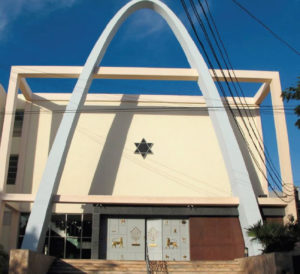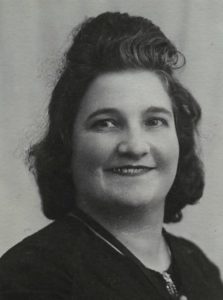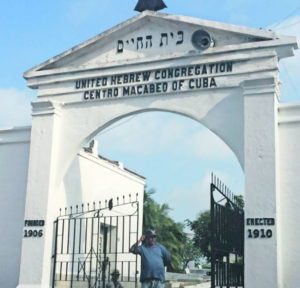 Jews first arrived in Cuba as conversos sailing with Columbus, who landed at this largest Caribbean island in 1492. In the latter half of the 1800s, a trickle of Jews began settling in Cuba. During the American intervention of 1898, a number of Jews of Romanian descent arrived in Cuba.
Jews first arrived in Cuba as conversos sailing with Columbus, who landed at this largest Caribbean island in 1492. In the latter half of the 1800s, a trickle of Jews began settling in Cuba. During the American intervention of 1898, a number of Jews of Romanian descent arrived in Cuba.
The Cuban Jewish community remained modest until the early 1900s, when Jews from Turkey and Thrace arrived after the fall of the Ottoman Empire. At the end of WWI, numbers swelled with poverty-stricken Poles from Grodno and Bialystok, Russians, Czechs and Hungarian Jews from Eastern Europe and Russia. In 1904, the United Hebrew Congregation was inaugurated and in 1906 they acquired a cemetery in the outskirts of Guanabacoa.
 By 1924 there were 24,000 Jews in Cuba, with many working in its garment industry. In the 1930s, additional Jewish immigrants came from Europe as a result of Nazi and fascist persecution; some hoped to get to the United States but decided to stay in Cuba. Refugees from Belgium introduced the diamond industry into Cuba; at its height there were 24 factories with approximately 1,000 workers.
By 1924 there were 24,000 Jews in Cuba, with many working in its garment industry. In the 1930s, additional Jewish immigrants came from Europe as a result of Nazi and fascist persecution; some hoped to get to the United States but decided to stay in Cuba. Refugees from Belgium introduced the diamond industry into Cuba; at its height there were 24 factories with approximately 1,000 workers.
Amparo de Los Remedios Otero Pappo was a Cuban-born milliner who was honored as being among the Righteous Among the Nations by Yad Vashem for saving French Jews during the Holocaust.
 Àmparo Otero emigrated with her family from Cuba to France in the late 1920s, settling in Paris to pursue a hatmaking career. A Catholic, she married Jacob Pappo, a Bulgarian Jew, in 1931. They had a son, Charles-Henri, in 1932, and Jacob Pappo died the following year. After World War II began, she relocated with her son to Siran, Cantal. During the war years, Pappo sheltered her husband’s family – including her mother-in-law, brother-in-law, sister-in-law, nephews and niece – and a teenage Jewish refugee named Liliane Frangi from arrest and potential deportation to the Nazi death camps.
Àmparo Otero emigrated with her family from Cuba to France in the late 1920s, settling in Paris to pursue a hatmaking career. A Catholic, she married Jacob Pappo, a Bulgarian Jew, in 1931. They had a son, Charles-Henri, in 1932, and Jacob Pappo died the following year. After World War II began, she relocated with her son to Siran, Cantal. During the war years, Pappo sheltered her husband’s family – including her mother-in-law, brother-in-law, sister-in-law, nephews and niece – and a teenage Jewish refugee named Liliane Frangi from arrest and potential deportation to the Nazi death camps.
The first Jewish community in Santiago was founded October 1924. It was called Sociedad Union Israelita de Oriente de Cuba (the Jewish Society of Eastern Cuba). That institution was located in a rented space until 1939 when a new house was built. It was thereafter called the Sinagoga de Santiago de Cuba (the Synagogue of Santiago de Cuba) and the congregation relocated there. The Synagogue has had two rabbis. Señor Isaac Chiprut Confi served from 1924 until 1943, and Señor Victor Farin Sarfati, from 1946 until 1967. The Beth Shalom Synagogue, the main one of three in Havana, was built in the early 1950s. Nearly 95% of Jews left Cuba for the United States after the arrival of Fidel Castro and his implementation of a communist government. As part of the middle class, some Jews were made to serve in forced labor camps in the 1960s, but they were not targeted as an ethnic group by Castro’s government.
 In 1959, Cuban Jews numbered 15,000. The vast majority lived in Havana, which supported five synagogues, five Jewish elementary schools, a Jewish high school, and a kosher restaurant. But after the Revolution, 90 percent of Cuba’s Jews emigrated, most of them to Miami.
In 1959, Cuban Jews numbered 15,000. The vast majority lived in Havana, which supported five synagogues, five Jewish elementary schools, a Jewish high school, and a kosher restaurant. But after the Revolution, 90 percent of Cuba’s Jews emigrated, most of them to Miami.
There are about 1,500 known Jews living in Cuba, with about 85 percent living in Havana. There are also Jewish families in Santiago, Camaguey, Santa Clara, Cienfuegos, Sancti Spiritus, Guantánamo, Holguín and a few other locations. Cuba has one kosher butcher shop on the entire island. For a time it had no rabbi, but by 2007, one was based in a Havana synagogue.